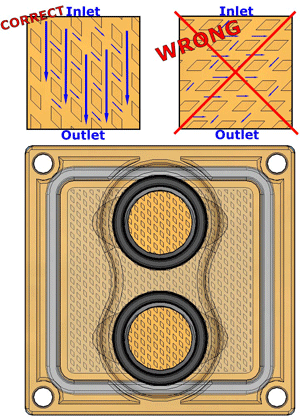January 13, 2007
During the course of our live CPU testing, we uncovered the fact that the overall performance of the Apogee GT water-block could greatly benefit (by up to 0.03°C/W) by artificially inducing a bow i.e. a convex shape, in the water-block base plate.
In CPU's where the geometrical center of the Integrated Heat Spreader (IHS) coincides with the geometrical center of the water-block base plate, an artificially induced bow in the water-block base plate increases the contact pressure at the geometrical center of the IHS and can be further qualified as a pressure gradient applied to the entire surface of the CPU IHS with a maximum pressure value at its geometrical center. The observable result is an improvement in the thermal joint between the CPU IHS and the waterblock base plate in the general area directly above the CPU die(s), while the water-block thermal resistance remains approximately the same.
The following graph shows the actual difference in thermal resistance between the Apogee GT with a flat base plate (as shipped) and the Apogee GT with a bow artificially induced by replacing the original 2.6mm wide o-ring with a 3mm wide o-ring. Between .5 and 2 GPM a difference is observed that is never lower than 0.02 °C/W.
Improvements have been measured and noted using our standard thermal test vehicles (as reported in the above graph), as well as "live" CPU's. Among the "live" CPU's that we tested, one was lapped flat (our Intel Core 2 QX6700 quad-core), and the other (our Intel Core 2 E6400) was kept stock, i.e. unmodified. Improvements ranging from 2 to 3 °C were noted in both cases. Lastly, tests were conducted with an AMD Athlon 64 3800+ and showed no appreciable differences. This result could be explained by the modest heat load generated by this processor, and the lack of resolution (±1°C) of the software reporting its temperature.
It should also be noted that it is well known in the industry that there are relatively substantial variations in the flatness of stock heat spreaders: some are flat, some are convex, some are concave, some are irregular with high corners low mid-section and a high center etc.. We simply cannot predict with any degree of certainty the amount of performance improvement -if any, or conversely of degradation that could occur in the thermal joint because of the variations in the stock IHS surface state.
What we can say so far, is that we have measured improvements, no degradations, and that improvements when present can be relatively substantial. We can also venture to say that CPU heat spreaders that have been lapped flat should in theory yield improvements in most cases, noting that such practice is exclusively reserved to the most advanced users, and that it will always result in voiding the manufacturer warranty.
In order to enable those users who wish to optimize the performance of their Swiftech equipment, all Apogee GT water-blocks shipped after 1-15-07 will include a spare 3mm o-ring so that such advanced users can conduct testing and tweaking of their own. Pre-launch shipments delivered to dealers before 1-15-07 do not include the spare o-ring, and such will be mailed on demand to US consumers free of charge (proof of purchase required).
The above article is meant as a work in progress. Further validation is necessary to verify the above findings. Furthermore Swiftech assumes no liability, expressed or implied for any damages directly or indirectly resulting from the above findings, the use of their products, and more specifically for any, and all damages caused by the use of Swiftech products to any other device(s) in a personal computer, whether due to product failure, defect, or leak. The use of accessories provided by Swiftech for Swiftech products is not a cause for breach of warranty to said products, more specifically, the use of the 3mm o-ring discussed here above does not void the Apogee product warranty.
INSTALLATION NOTES:
1/ O-ring replacement:
Using a dab of grease inside and at each corner of the o-ring groove will ease o-ring installation
2/ Base-plate orientation:
The Diamond Pin Matrix requires proper base-plate orientation in relation to the intlet and outlet ports as shown below:
